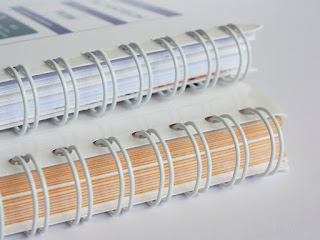Add Order and Finesse with Versatile Binding Solutions
Your home wouldn’t be complete without the paint, and print projects also come alive when you add beautiful finishes.
Binding is a necessary step for compiling multi-page documents, and you have many options to work with. Here is a quick reference guide of several formats that might be a good fit for your project.
Case Binding
Case binding attaches a hardboard book cover to a bound set of pages.
Case binding is timeless, classy, and typically requires around 60 pages (approximately 1/8 inch) of content. Since the hardcover makes the binding so sturdy, case binding is ideal for documents that will be handled frequently and need to hold up over time. While this method offers immense durability, it is usually the most time-consuming and expensive process.
In case binding, using an adhesively bound – or hinged – cover with a flexible joint can allow your book to open without breaking the spine. (Hinged covers are scored 1/8 inch from the spine, so books can open more easily.)
Coil Binding
Coil binding uses a piece of spiraled plastic or wire (looped through a series of punched holes) to hold the finished book together.
Also called spiral binding, this format allows a book to be laid flat when opened or even folded over onto itself. This is a wonderful binding option for reports, instruction manuals, cookbooks, calendars, and other items that need both flexibility and the ability to stay open. Spiraled binding comes in over 60 different colors that can be matched to your cover art or brand colors, so the project really pops.
Alternatives include wire-o binding (which uses a double set of wire loops instead of a single spiral) or even several gorgeous fabric options, like those used in Japanese ribbon binding.
Perfect Binding
Perfect binds secure papers together at the spine using glue that attaches them to a wraparound cover.
This is the preferred binding method for most paperback books because perfect binding is a lightweight, cost-effective option for large volume booklets. A variation is lay-flat binding, which allows publications to open completely flat across a centerfold, so images can run across both halves of the spread with minimal disruption.
Plastic Comb Binding
Plastic comb binding is the most common of the punch and bind styles.
Comb-bound documents are cost-efficient and easy to edit and can be reused as many times as you need. Combs come in many different colors and are capable of binding even very thick documents. And they can be customized! Add your document title, company name, or quick reference handle to the comb spine to make your binding more professional.
If resilience is a priority, remember the teeth of a plastic comb tend to break over time.
Post Binding
This mechanical binding process inserts metal or plastic posts through punched or drilled holes in pages to hold them together.
One advantage of post binding is it allows pages to be added (and the post extended) as the size of a publication increases. And the screws or spikes used bring a sleek, polished feel to your piece.
An alternative to post binding is Velo binding, which applies heat to two plastic binding strips, so the spine cannot be opened and re-closed without a Velobind machine. Velo binding cannot be tampered with or easily photocopied, so this is an excellent option for sensitive legal or financial documents.
Binding methods vary and can be uniquely tailored to the design specifications of your project. Add order and finesse with this beautiful finishing touch.




Comments
Post a Comment